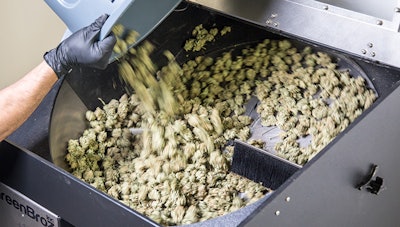
This article originally appeared in the September/October print edition of Cannabis Business Times. To subscribe, click here.
Cannabis growers see green each time a new medical or consumer market opens. While this is generally considered good news for the industry, many growers quickly find they’re unprepared for the volume increase. Trimming is one of the more time-consuming processes that can hamper a grower’s ability to meet customer demand.
Some growers are turning to trimming machines to speed production by eliminating the labor-intensive process of hand trimming. Forbidden Farms, a Tier 3 producer based in Tacoma, Wash., implemented a trimmer to accommodate the introduction of recreational cannabis in Washington, says Taylor Balduff, company president.
“Before, it was no big deal to hand trim, but when you’re doing hundreds of pounds per week, the man-hours and staff to hand trim something like that was unreal,” Balduff says.
With trimming machines, Forbidden Farms can process approximately 100 pounds per day versus 1 to 2 pounds each day by hand. The machine paid for itself after the first harvest, Balduff says.
Likewise, Alex Cooley, owner of Seattle-based Solstice Grown, says his efficiencies increased tenfold after introducing trimming machines. In addition, his company has been able to cut trimming time from weeks to days, with a return on investment in less than six months.
Increased efficiencies made the investment worthwhile for Solstice and Forbidden Farms, but growers can’t expect the same returns with every trimmer. About six years earlier, Balduff experienced mixed results using a trimmer that handled only wet material.
He has since switched to a dry-trimming process that has produced much better results, he says.
Like any technology investment, cultivators have many factors to consider when shopping for trimmers. Below are five keys to consider when purchasing trimming equipment.
To read the full article in our September/October edition, click here.
Cannabis growers see green each time a new medical or consumer market opens. While this is generally considered good news for the industry, many growers quickly find they’re unprepared for the volume increase. Trimming is one of the more time-consuming processes that can hamper a grower’s ability to meet customer demand.
Some growers are turning to trimming machines to speed production by eliminating the labor-intensive process of hand trimming. Forbidden Farms, a Tier 3 producer based in Tacoma, Wash., implemented a trimmer to accommodate the introduction of recreational cannabis in Washington, says Taylor Balduff, company president.
“Before, it was no big deal to hand trim, but when you’re doing hundreds of pounds per week, the man-hours and staff to hand trim something like that was unreal,” Balduff says.
With trimming machines, Forbidden Farms can process approximately 100 pounds per day versus 1 to 2 pounds each day by hand. The machine paid for itself after the first harvest, Balduff says.
Likewise, Alex Cooley, owner of Seattle-based Solstice Grown, says his efficiencies increased tenfold after introducing trimming machines. In addition, his company has been able to cut trimming time from weeks to days, with a return on investment in less than six months.
Increased efficiencies made the investment worthwhile for Solstice and Forbidden Farms, but growers can’t expect the same returns with every trimmer. About six years earlier, Balduff experienced mixed results using a trimmer that handled only wet material.
He has since switched to a dry-trimming process that has produced much better results, he says.
Like any technology investment, cultivators have many factors to consider when shopping for trimmers. Below are five keys to consider when purchasing trimming equipment.
To read the full article in our September/October edition, click here.

























